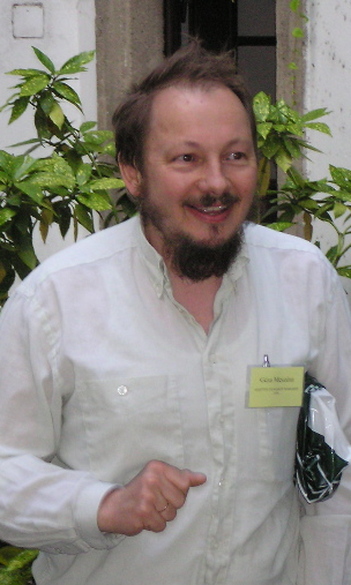Géza Meszéna

retired full professor
PhD (Hungarian Academy of Sciences, Budapest, 1994)
Habilitation (Eötvös Loránd University, Budapest, 2006)
Doctor of HAS (2007)
Department of Biological Physics
Room(s): Lágymányos Campus, Northern Building 3.79Phone(s): +36-1-372-2786
Extension(s): +36-1-372-2500 / 6326
Mobile(s): +36-20-973-9204
Homepage: gezameszena.web.elte.hu
Email: uh.etle@anezsem.azeg
Biography:
Research interest: theoretical ecology & evolutionTeaching: physics, evolution
Links to associated scientific database profiles:
- Publications in MTMT
- Publications in ORCID
- Publications in ResearcherID
- Publications in Scopus
- Publications in Google Scholar
- User profile at doktori.hu
Selected publications of recent years:
- G. Meszéna & U. Dieckmann: Three-phase transitions to reproductive isolation: The roles of utilization mismatch and residual selection (2019) DOI
- A. G. Rossberg, G. Barabás, H. P. Possingham, M. Pascual, P. A. Marquet, C. Hui, M. R. Evans & Géza Meszéna: Let’s train more theoretical ecologists – here is why, Trends in Ecology and Evolution 34(9): 759-762 (2019) DOI
- Liz Pásztor, Zoltán Botta-Dukát, Tamás Czárán, Gabriella Magyar & Géza Meszéna: Theory Based Ecology: a Darwinian approach (in production, Oxford University Press, 2016
- Zs. Vásárhelyi, G. Meszéna & I. Scheuring: Evolution of heritable behavioural differences in a model of social division of labour. /PeerJ/3:e977 (2015) DOI
- G. Barabás, L. Pásztor, G. Meszéna & A. Ostling: Sensitivity analysis of coexistence in ecological communities: theory and application. Ecology Letters 17(12): 1479-1494 (2014) CrossLink
- G. Barabás, R. D’Andrea, G. Meszéna & A. Ostling: Emergent neutrality or hidden niches? Oikos 122(11):1565-1572 (2013)
- G. Barabás, S. Pigolotti, M. Gyllenberg, U. Dieckmann & G. Meszéna: Continuous coexistence or discrete species? A new review of an old question. Evolutionary Ecology Research 14: 523-554 (2012)
- G. Barabás, G. Meszéna & A. Ostling: Community robustness and limiting similarity in periodic environments. Theoretical Ecology 5: 265-282 (2012) CrossLink

